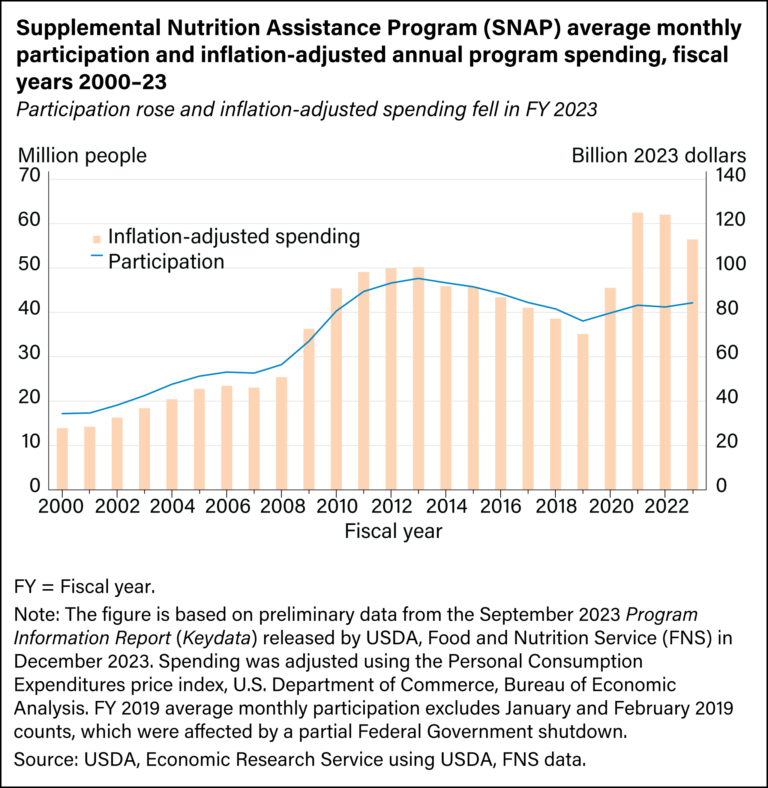By Ryan Hanrahan
Politico’s Grace Yarrow reported that “the House Ag Committee is eyeing roughly $150 billion in spending cuts related to the Supplemental Nutrition Assistance Program as Republicans are seeking to pay for President Donald Trump’s agenda.”
“That number includes reducing SNAP error payment rates, updating work requirements and tying future updates to the Thrifty Food Plan — the basis for cutting SNAP — to a cost of living adjustment, limiting how much it can be updated,” Yarrow reported. “Limiting Thrifty Food Plan updates, as House Ag Chair G.T. Thompson (R-Pa.) is now planning to do in reconciliation, was originally included in Thompson’s farm bill that advanced out of committee in May 2024. That provision was a crucial way for Republicans to pay for other policy changes like strengthening the so-called farm safety net for farmers grappling with difficult economic conditions.”
“‘Ag has been required to and will be required to come up with their fair share [of reconciliation cuts]. How that plays then when you actually get around to doing the 2025 farm bill … that remains to be seen,’ Rep. Frank Lucas (R-Okla.) said,” according to Yarrow’s reporting. “‘But various of us have discussed with each other how we can’t give everything in the first call. You’ve gotta have some resources to work with [for the farm bill].'”
“Hardliners in the House GOP caucus are continuing to pressure their colleagues to find more savings. The Senate has stepped in to move forward with the process as House Republicans scramble,” Yarrow reported. “Thompson’s rough plan of $150 billion savings is still only half of what House Budget Chair Jodey Arrington (R-Texas) had mapped out — without consulting committee chairs — weeks ago.”
“Limiting Thrifty Food Plan updates was one of Democrats’ top red lines during farm bill talks last year and led to the stalemate that pushed negotiations into 2025,” Yarrow reported. “‘If Republicans want to start the year by cutting SNAP for tax breaks for people who are already rich, then that is going to be very troublesome to any sort of bipartisan farm bill discussion,’ Rep. Angie Craig (D-Minn.), the top Democrat on the House Ag Committee, told POLITICO in an interview. ‘G.T., who I respect tremendously, has a challenge here,’ Craig added.”
SNAP Work Requirements May Be Expanded
Politico’s Benjamin Guggenheim and Meredith Lee Hill reported that “prominent House Republicans are privately warring over how to advance tax cuts that are expiring and President Donald Trump’s long list of other tax demands — with Budget Chair Jodey Arrington and deficit hard-liner Rep. Chip Roy locked in a struggle against Ways and Means Chair Jason Smith and other senior Republicans.”
“The dispute is hindering Speaker Mike Johnson ’s plan to advance a budget blueprint this week, as different GOP factions continue to squabble over the costs of the tax plan, how to offset them to reduce their deficit impact and possible cost-saving changes to programs including Medicare and assistance for low-income Americans,” Guggenheim and Lee Hill reported. “Republicans are also planning to include enacting the first-ever work requirements for Medicaid in the package, according to two people familiar with the ongoing talks. They’re also planning to expand work requirements for SNAP food aid benefits that help feed more than 40 million low-income Americans and a smaller cash assistance program known as Temporary Assistance for Needy Families.”
“The work requirements can be adjusted depending on how big of a funding gap they need to fill, according to Republicans involved in the discussions,” Guggenheim and Lee Hill reported. “For example, they can increase the age range of the additional work requirements if needed, along with plans to rescind the ability of states to request federal waivers for SNAP work requirements for certain individuals and other flexibilities in the program.”
SNAP Enrollment Remains High
The USDA Economic Research Service’s Jordan W. Jones reported at the beginning of January that in fiscal year 2023, “SNAP served an average of 42.1 million participants per month. Federal SNAP spending totaled $112.8 billion and benefits averaged $211.93 per participant per month. The share of U.S. residents who received SNAP benefits in FY 2023 was 12.6 percent.”

Source : illinois.edu